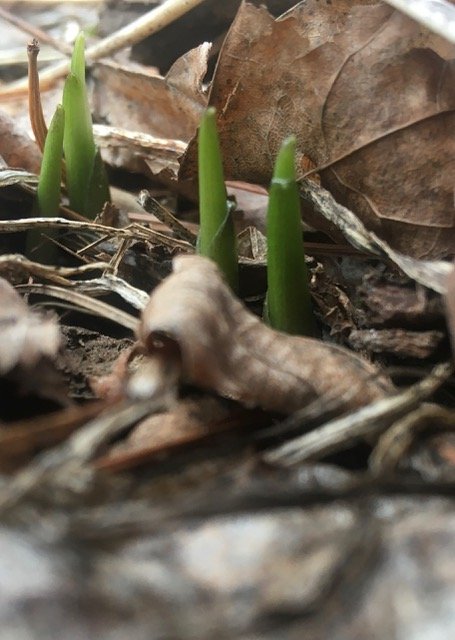INTRODUCTION
Beth Harris is a Malden resident and a harpsichord technician by trade. Through her walks, bike rides, and reading, she learned about the flora and fauna of the Mystic River watershed and began thinking of ways to use local, natural materials to live more sustainably. In this second guest blog, Beth talks about some of the edible non-native and invasive species that you can find around the watershed during springtime and how she makes use of them through cooking.
by Beth Harris
Spring! The aroma of moisture and soil fresh in the air, so refreshing after the winter's cold, frozen smell. The sun returns from its winter home with new yellow warmth. I walk outside and my skin prickles with aliveness. I find myself watching the ground constantly. Early in the season, I see many single use plastic water bottles and other bric-a-brac, blown from recycle bins during the winter, or discarded carelessly by my fellow humans. These I pick up with a sigh and deposit in my own bin or the trash, with the satisfaction at least of knowing they won't end up in the river.
Garlic mustard sprouts (PC: Beth Harris)
As the season really turns however, I am greeted by more exciting gifts from the soil. Appearing initially as little rosettes close to the ground, garlic mustard is one of the first on the scene, a prolifically self-seeding biennial. This plant has become a problematic invasive species in many areas including ours. In its first year garlic mustard stays close to the ground, but in its second year in shoots up with distinctive triangular leaves and white flowers before making hundreds of seeds and dying by the end of spring. Even more distinctive, the leaves smell garlicky when crushed, so even when they are small I find myself picking a leaf here and there to hone my ID skills. After it starts getting tall and before it goes to seed, I pick it both to remove it and for eating. I like the leaves in stir fries with milder greens (it packs a mustardy punch), and they provide the first pesto making opportunity of the year. I do seem to end up wanting to remove more than I want to eat, so I can attest that is also livens up a compost pile beautifully.
Hosta sprouts (PC: Beth Harris)
Some perennial plants wake up quickly, and get on with growing in earnest as soon as they break ground. I try to catch a few new hosta shoots in the yard just at the moment when they look like spears, before their leaves open out. I've harvested some of my excess hostas repeatedly, and they haven't even blinked, but I tend to keep to well established plants. New hosta shoots taste mild and a little sweet. Once they get big, they're kind of stringy and tough, but otherwise, pretty hard to go wrong with.
Japanese Knotweed sprouts (PC: Beth Harris)
Hosta puts me in the mind of another spear producer, the far more aggressive and infamous Japanese Knotweed. These spears can grow at a rate of an inch a day (a day!) and are most edible between 2 and 10 inches... you do the math. I make an effort to leave all root matter in situ, and cut them off instead. The risk of it taking root in the compost or elsewhere is too high, and once established, this plant is destructive and difficult to remove (I'll leave that to the pros). Picked and in the kitchen however it is both safe and interesting. Adventures in the cookpot! The first time I cooked Japanese Knotweed I was expecting something like rhubarb (based on my internet reading). Rhubarb, if you haven't experienced it, is pink, tangy, and with a little sugar added, completely amazing. The Japanese Knotweed was, uh, not pretty and pink. It was yellowish green, and lumpy. And even with a little sugar, it maintained a certain savoriness, which did not belong on my morning cereal. My reaction upon tasting it was like "Huh... Ooo!... Huh." Not bad, but confusing. Since then I have discovered that I like it best in savory/sweet dishes, such as with apples and sausage. It that context it earned its place at my table.
A little later in the season, around the edges of the local Knotweed infestations, I begin watching the burdock plants for their biennial offering. These plants have huge leaves and in their second year of growth send ip a nice fat flower stalk, and if you can catch it before it flowers, the stalks taste wonderful (kind of like artichoke) peeled and sauted with a little butter. The roots of this plant are also very edible, but I let them alone, as I'm picking in a public area. I also have read that young leaves are technically safe to eat, but I can attest that they taste awful, so now I stick strictly to young stalks.
The spring and its numerous changes fly by in a kaleidoscope of colors, scents and tastes, each as interesting as it is ephemeral. I delight in the opportunity to explore the new things growing at my fingertips. Soon enough we'll settle into the slower pace of summer.
If you are interested in finding ways to cook and eat the invasive plants in your yard (or another place where you have permission to forage), stay tuned for future blog posts!









